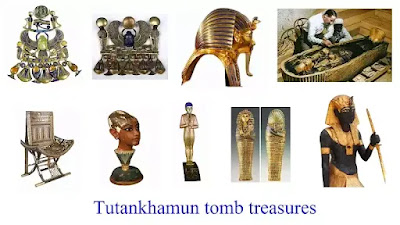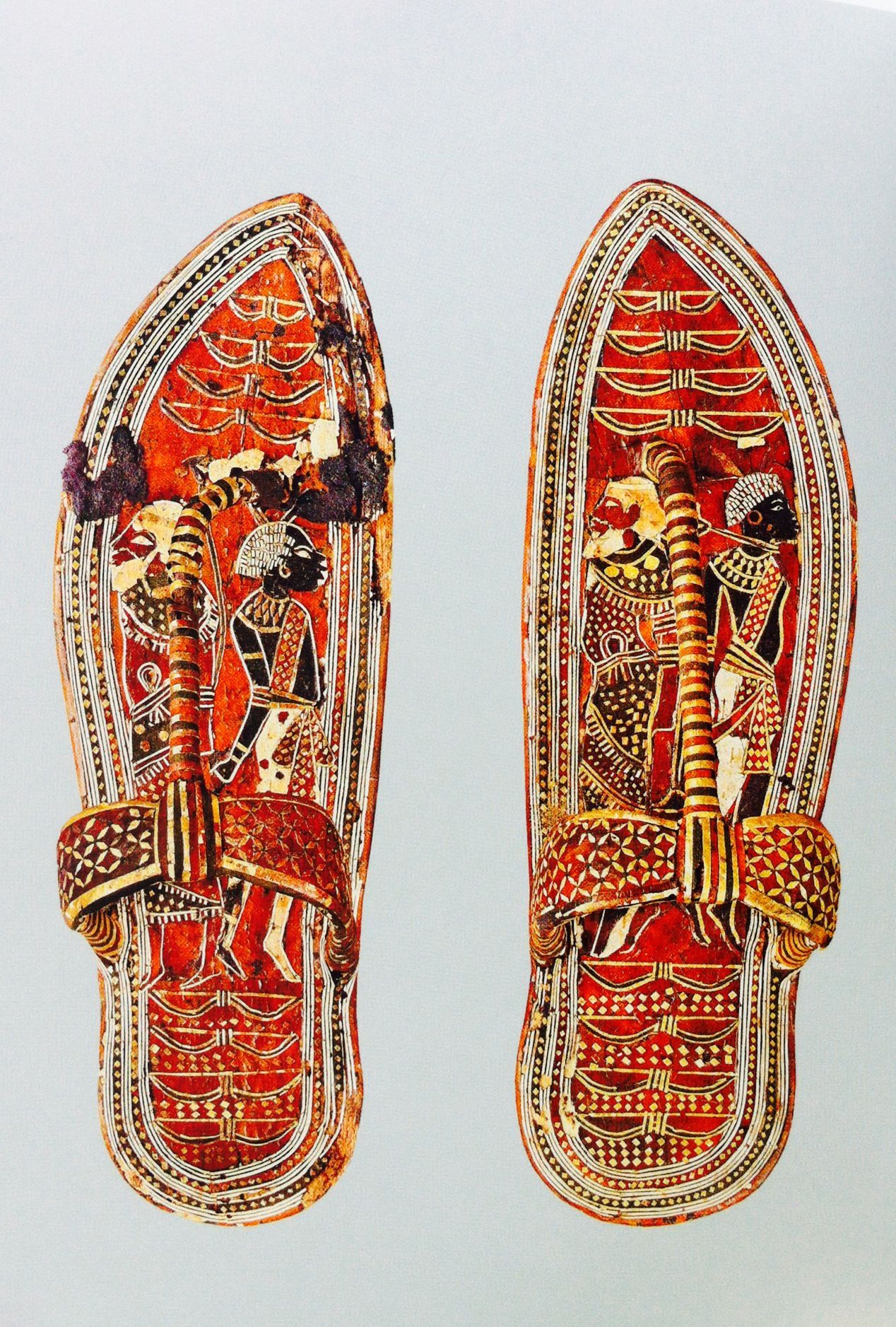The Golden Throne was discovered in 1922 by the British archeologist Howard Carter during excavations of the tomb of pharaoh Tutankhamun. King Tuts tomb contained among other things elaborately decorated flip-flops with marquetry veneer.
Howard Carters discovery of Tutankhamuns tomb in 1922 is one of the most significant archaeological finds of all time.

The soles of king tut's sandals depicted. However since the famous discovery of the tomb in 1922 much of the material remains understudied or unpublished. They were shown on the kings feet in some late Eighteenth Dynasty tomb reliefs such as the scene on the south wall of the tomb of Tutankhamun where pharaoh is depicted between Anubis and Hathor. It took 10 years for Carter and his team to clear the artifacts of the tomb and a large number of shoes and sandals were among the items discovered.
Each ring depicted some of the most important gods and goddesses whose cults King Tut had restored after their destruction by his predecessor Akhenaton. In terms of religious beliefs social structures material culture and burial rituals the tomb of Tutankhamun provides Egyptologists with unprecedented knowledge and understanding of kings during the 18th dynasty. It is believed that since the temperature in Egypt was very high throughout the year people gave less importance to wearing footwear.
Two pairs of open shoes had the middle part of the sole stuffed for extra comfort. But it was the plain palm leaf and papyrus sandals that really. The physical features of both the king and the queen such as the elongated face slim waist heavy hips slim legs and the sandals.
Tutankhamun had at least 42 pairs of sandals buried in his tomb with him. Statues and statuettes of Tutankhamun from the tomb show him wearing golden sandals. Above and below are groups of four bows which together with the captives represent the nine traditional enemies of Egypt whom the king symbolically trod underfoot when wearing the.
The other represented his ka wearing an Afnet headdress. The straps over the insteps are of bark ornamented with a diaper pattern in gold foil. The outer soles are covered with white stucco.
The king is represented wearing a composite crown which is similar to the Atef crown with more additions of serpents wearing solar discs and two feathers. Many sandals demonstrate the print of King Tuts foot on the sole. Explore the new season collection or shop bestsellers.
These sandals had paintings of his enemies on the soles so he could always trample on his foes. The outer soles are covered with white stucco. Express delivery available plus free returns globally.
Ad New arrivals every week. Their clothing and jewellery are gilded with gold and. The royal throne of Tutankhamun is a unique work of art.
Indeed many sandals show wear including the print of King Tuts foot on the sole Veldmeijer said. Explore the new season collection or shop bestsellers. Howard Carters discovery of Tutankhamuns tomb in 1922 is one of the most significant archaeological finds of all time.
The rings each have a full figured deity and hieroglyphics that show beautiful detail and symmetry. The front scene of the throne. It took 10 years for Carter and his team to clear the artifacts of the tomb and a large number of shoes and sandals were among the items discovered.
Soles of course have a long history as a signifier of a luxury goodand indeed even shoes themselves have been used to convey the wearers wealth and status at least since ancient Egyptian times when beautiful sandals were a powerful enough sign of rank to be depicted on tomb reliefs. We only know them from the archaeological record He added You can see the various steps used by the Egyptians to turn sandals into completely closed shoes the evolution of a new form. Tutankhamun remains one of ancient Egypts most iconic pharaohs.
King Tuts treasure-packed tomb included 81 pairs of shoes in varying stages of decay. One pair also had semi-circular panels at the shoes sides. Both have skin coloured with black resin symbolizing regeneration and hold a staff and mace.
A pair of golden sandals found in King Tutankhamuns tomb that shows how Egyptian sandals were made During the ancient Egyptian period people mostly traveled barefoot. The placement of these drawings symbolizes King Tut trampling over his enemies. His tomb was the only tomb in the Egyptian Valley of the Kings that wasnt robbed.
The straps over the insteps are of bark ornamented with a diaper pattern in gold foil. These sandals are made of wood and overlaid with a marquetry veneer of bark green leather and gold foil on a stucco base. One statue depicted Tutankhamun wearing the Nemes head cloth.
Ad New arrivals every week. One pair also had semi-circular panels at the shoes sides. Two pairs of open shoes had the middle part of the sole stuffed for extra comfort.
Express delivery available plus free returns globally. Tutankhamun between Anubis and Hathor wearing white sandals. With their heat and humidity Egyptian tombs arent the ideal places.
Many sandals demonstrate the print of King Tuts foot on the sole. Three pairs had horizontal straps just below the toes. King Tuts sandals were found with him inside his tomb.
Two pair of open shoes were made to be extra comfortable with. The ancient Egyptian boy king had a size 8 or 9 foot and a closet-full of 81 elaborate shoes glittering with gold and gemstones. Three pairs had horizontal straps just below the toes.
Tutankhamun wore orthopaedic sandals. He became a trend three millennia after his death. They had drawings on the soles of his enemies.
On the inner sole are figures of Negro and Asiatic captives bound with stems of lotus and papyrus. The variety of footwear is much greater than imagery suggests and even includes shoes that are never depicted. One of the most peculiar artworks found in King Tuts tomb was a headrest.
The ancient Egyptian king reigned from 1330 to 1323 BC. Here are ten key facts about Tutankhamun the boy king. Tutankhamun was buried with 130 walking sticks to help with his clubbed foot which he often wore orthopaedic sandals for.
Tut Exhibit King Tutankhamun Exhibit Collection Other Items Wood Sandals

Was Jesus Black Crossroads Bible Church

212 Egypt Museum Tutankhamun S Sandals Egyptians

The Bottom Of King Tut S Sandals Depicted What Youtube
Tutankhamun Sandals Depicting Egypt S Enemies

